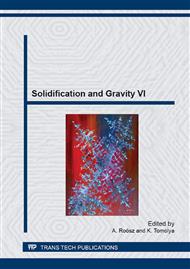[1]
J. Gilbert Kaufman, Properties of Aluminum Alloys, Aluminum Association, Ohio, (1999).
Google Scholar
[2]
Welding Handbook, Vol. 1, 7th Ed., American Welding Society, Miami, (1976).
Google Scholar
[3]
M.M. Schwartz, Metals Joining Manual, McGraw-Hill, New York, (1979).
Google Scholar
[4]
S. Kou, Welding Metallurgy, 2nd Ed., John Wiley & Sons Inc., Hoboken, New Jersey, (2003).
Google Scholar
[5]
S. Vernède, M. Rappaz, A Simple and Efficient Model for Mesoscale Solidification Simulation of Globular Grain Structures, Acta Mater. 55 (2007) 1703-1710.
DOI: 10.1016/j.actamat.2006.10.031
Google Scholar
[6]
S. Vernède, P. Jarry, M. Rappaz, A Granular Model of Equiaxed Mushy Zones: Formation of a Coherent Solid and localization of Feeding, Acta Mater. 54 (2006) 4023-4034.
DOI: 10.1016/j.actamat.2006.04.035
Google Scholar
[7]
S. Vernède, M. Rappaz, Transition of The Mushy Zone from Continuous Liquid Films to a Coherent Solid, Philos. Mag. 86 (2006) 3779-3794.
DOI: 10.1080/14786430500228705
Google Scholar
[8]
A.B. Phillion, J.L. Desbiolles, M. Rappaz, A 3D Granular Model of Equiaxed-Granular Solidification, Modeling of Casting, Welding, and Adv. Solidif. Processes, TMS, 2009 353-359.
Google Scholar
[9]
A. Phillion , S. Vernede, M. Rappaz, S.L. Cockcroft, P.D. Lee, Prediction of Solidif. Behaviour Via Microstructure Models Based on Granular Structures, Int. J. Cast Met. Res. 22 (2009) 240-243.
DOI: 10.1179/136404609x367849
Google Scholar
[10]
M. Sistaninia, A.B. Phillion, J.M. Drezet, M. Rappaz, Three-Dimensional Granular Model of Semi-Solid Metallic Alloys Undergoing Solidification: Fluid Flow and localization of Feeding, Acta Mater. 60 (2012) 3902-3911.
DOI: 10.1016/j.actamat.2012.03.036
Google Scholar
[11]
M. Sistaninia, A.B. Phillion, J.M. Drezet, M. Rappaz, A 3D Coupled Hydro-Mechanical Granular Model for Simulating The Constitutive Behaviour of Metallic Alloys During Solidification, Acta Mater. 60 (2012) 6793-6803, (2012).
DOI: 10.1016/j.actamat.2012.08.057
Google Scholar
[12]
V. Mathier, A. Jacot, M. Rappaz, Coalescence of Equiaxed Grains During Solidification, Modelling Simul. mater. Sci. Eng. 12 (2004) 479-490.
DOI: 10.1088/0965-0393/12/3/009
Google Scholar
[13]
J.F. Zaragoci, L. Silva, M. Bellet, C.A. Gandin, Numerical tensile test on a mushy zone sample, Modeling of Casting, Welding and Advanced Solidification Processes XIII, 2012 IOP Conf. Ser.: Mater. Sci. Eng. 33 01207.
DOI: 10.1088/1757-899x/33/1/012054
Google Scholar


